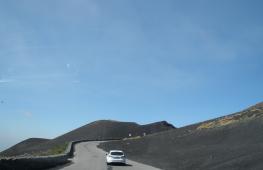The highest mountain in the world is Mauna Kea. Mauna Kea: Hawaii's highest mountain Mauna Kea
Which mountain is the highest in the world? It depends on how you measure them. There are two mountains that claim to be the tallest in the world. The summit of Mount Everest is higher above sea level than the summit of any other mountain, but Mauna Kea is the highest when measured from base to summit. Mauna Kea, an inactive volcano in Hawaii, is the tallest mountain in the world when measured from its base, deep in the Pacific Ocean, to its summit. Discussion of the height issue hinges on the fact that most of Mauna Kea in Hawaii is underwater, and therefore measuring from the aforementioned sea level does not do justice to the enormous size.
The summit of Mauna Kea is 4,205 meters above sea level, but it extends approximately 6,000 meters below the surface of the water. Therefore, the total height is 10,210 meters, which is almost one and a half kilometers more than Mount Everest, according to the United States Geological Survey (USGS). Thus, it is included in the list of the highest mountains in the world. 
In Hawaiian, Mauna Kea means "White Mountain" and its snowy peak attracts skiers and snowboarders. Its lower slopes are popular areas for hunting, hiking, sightseeing and bird watching. 
Its location near the equator makes Mauna Kea an excellent astronomical observation site. Low humidity and clear skies make weather conditions near the volcano's summit almost ideal for many of the world's leading space observatories. The mountain's distance from city lights and the island's stark lighting also help provide the atmospheric clarity that telescopes require.
Mauna Kea is currently home to 13 telescopes, including NASA's Infrared Telescopes, Caltech Observatory and Japan's Subaru Telescope, as well as the Keck Interferometer Telescope, the largest single-mirror telescope in the world. Mauna Kea Center webcams allow viewers online to witness these star observatories in action.
The summit of Mauna Kea holds another record. In addition to being the top of the tallest mountain in the world, it is also home to the largest astronomical observatory in the world. This observatory is located above 40% of the Earth's atmosphere. The atmosphere at the top of the mountain is extremely dry and almost free of clouds. This makes it an ideal location for an observatory. This is one of the few places where you can see snow in Hawaii - the elevation is high enough and cold enough to accumulate snow. 
In Hawaiian mythology, the peaks of the island of Hawaii are sacred, and Mauna Kea is one of the most sacred. An ancient law allowed only high-ranking tribal leaders to visit this peak. Ancient Hawaiians living on the slopes of Mauna Kea relied on its vast forests for food and quarried basalt from its slopes to make tools. In recent years, concerns about the vulnerability of the native species have led to court cases that have forced the Department of Land and Natural Resources to destroy all wild species on the mountain.
If you think that Everest is the tallest mountain in the world, then you are mistaken. Everest is the highest point on the planet. A point, but not a mountain. The record holder for height is in Hawaii. This is Mount Mauna Kea.
The fact is that there is a small incident here. What should be taken as height - the absolute indicator from the base to the top or the height above sea level? It is logical to assume that the size of a mountain should be determined by its absolute height. Imagine that you walked waist-deep into the water of some amazing beach, for example, Hanauma Bay in Hawaii, has your height changed? Of course not. So, the first place comes out to Mount Mauna Kea on the island of Hawaii of the archipelago of the same name.
Mauna Kea on the map
- Geographic coordinates 19.822098, -155.467083
- Distance from the state capital, Honolulu, approximately 300 km
- The nearest Hilo International Airport is about 45 km
The absolute height of Mauna Kea is 10,203 meters. Its peak is located at an altitude of 4,205 meters above the sea, but the rest is hidden in the depths of the Pacific Ocean. Thus, its height exceeds the height of Everest by 1355 meters, making it the highest mountain in the world.

Although it is actually a volcano (one of five on the island), approximately 1 million years old. About 500 thousand years ago it was powerful and very active. Gradually the volcanic activity died down. The last eruption occurred about 4,500 years ago. At the moment, the volcano is considered extinct. Even the American Geological Survey assigned the volcano the lowest activity rating.
Mauna Kea means White Mountain in Hawaiian. This is quite understandable, since in winter the top of the mountain is covered with a cap of snow. Tourists can even go skiing there. But not at the very top, where the wind speed exceeds 100 km/h, but a little lower. There is a completely normal road on the mountain, along which you can drive SUVs almost to the very peak.

According to Hawaiian lore, the island's peaks are sacred, and the Mauna Kea volcano is the most sacred of them all. Only the highest-ranking leaders of local tribes have the right to go there. Ordinary Hawaiians are prohibited from climbing.
Apparently, this ban does not apply to tourists and scientists, since the former climb 100 thousand a year to the top of Mauna Kea, and the latter have set up as many as 13 observatories there. By the way, these astronomical centers belong to 11 countries.

It’s not for nothing that astronomers liked the mountain, because it is one of the best places for observing space. The altitude of the location, proximity to the equator, and minimal cloudiness create ideal conditions for this. But there are still disagreements with the local population about the legality of building scientific centers in a sacred place. Plus, a large number of tourists can harm the ecology of the volcano. There is debate about this too.
- This is the highest point in Hawaii
- According to scientists, the volume of Mauna Kea is more than 3,200 cubic kilometers
- The volcano occupies 22.8% of the entire island
Mauna Kea photo





Few people know that Mauna Kea, located in Hawaii, is considered higher than Everest. True, only the peak of this giant can be seen above sea level, since it protrudes from the water at 4205 meters. The rest of the mountain is hidden from view, so it is rare that this mountain is among the highest. The absolute height of the peak is 10,203 meters, which exceeds Everest by more than a kilometer.
Mauna Kea - a dangerous volcano or a calm mountain?
The volcano is classified as a shield volcano due to its shield-like shape. In pictures the crater is not clearly expressed and most often looks like a caldera. This species appears due to frequent eruptions of high temperature liquid lava. The magma flow in this case covers the entire surrounding area and forms a slightly sloping slope. 
Mauna Kea appeared a million years ago, and its peak activity ended 250,000 years ago. Currently, researchers classify it as extinct and set minimum values for the probability of awakening. Shield volcanoes typically go through several stages:
- pre-panel – occurs from the moment the hot spot is formed;
- shield period – is the most active period;
- post-shield – the form is finally formed, but the behavior is already predictable;
- inaction.
Today it is the highest mountain in the world, most of which is under water. It is part of the Hawaiian archipelago and one of the most striking attractions of Hawaii. What makes Mauna Kea special is its snow cap, which is rarely seen in tropical climates. That is why the name appeared, meaning “White Mountain”. 
Tourists come here not only to soak up the beach, but also to go skiing or snowboarding. The view from the mountain is stunning, so you can take beautiful photos or just walk around the surrounding area, because there are several nature reserves here due to the presence of dozens of endangered endemic species.
World Observatory
Since Hawaii is located close to the equator, the island becomes an ideal place for astronomical observations. It is not surprising that the highest mountain in the world has become a real center for the study of celestial bodies. Mauna Kea is located far enough from the city that the lights are not likely to spoil the view, resulting in ideal atmospheric clarity. 
Today there are 13 telescopes from different countries on the mountain. Among the most significant are the Keck Interferometer Telescope, NASA Infrared Telescopes and the Japanese Subaru Telescope. If you want to take a look at this large-scale center for astronomical research, you can connect to a webcam that allows you to watch the work of the observatories online. 
Not everyone knows that Mauna Kea is famous for another record. Not only are telescopes from eleven countries gathered at the summit, but they are also located at the highest point, exceeding 40% of the atmospheric layer. At this altitude, relative dryness is achieved, so no clouds form, which is ideal for year-round stargazing.
Flora and fauna of the giant mountain
Mauna Kea is an amazing place with several nature reserves. Each of them occupies a certain area depending on the height of the mountain. The summit is a rather aggressive environment with high illumination and solar radiation. This is an alpine zone characterized by low temperatures and strong winds. 
The flora in this zone consists of perennial low-growing grasses, most of which are evergreen. In the Alpine Belt Nature Reserve, they are trying to monitor an endangered species of wolf spider, which chooses altitudes of more than 4,000 meters as its habitat. Forest scarf butterflies are also found here; they hide from the cold between the stones.
The second layer is occupied by a reserve protecting the Golden-leaved Sophora. These leguminous trees grow exclusively in Hawaii, but their population declined significantly after Europeans arrived on the island in the 18th century. Currently, the number of trees is 10% of the original forest size. The area of the reserve is estimated at 210 square meters. km. 
The lower elevation of Mauna Kea is the third reserve, which is home to endangered species of plants and birds. Ecosystems have been severely damaged by imported cattle and sheep, as well as extensive clearing for sugar plantations. To preserve endangered species, it was decided to eradicate introduced species from the island.



